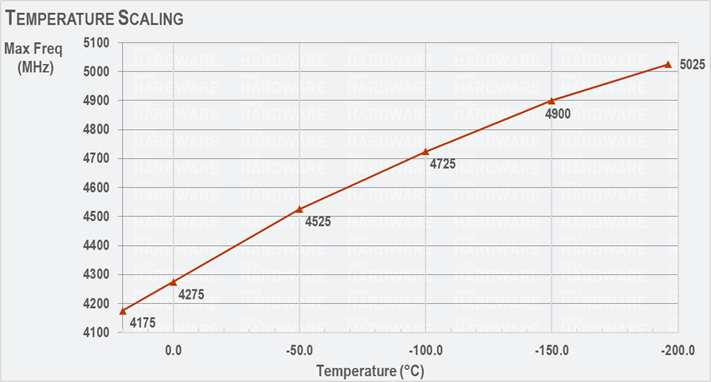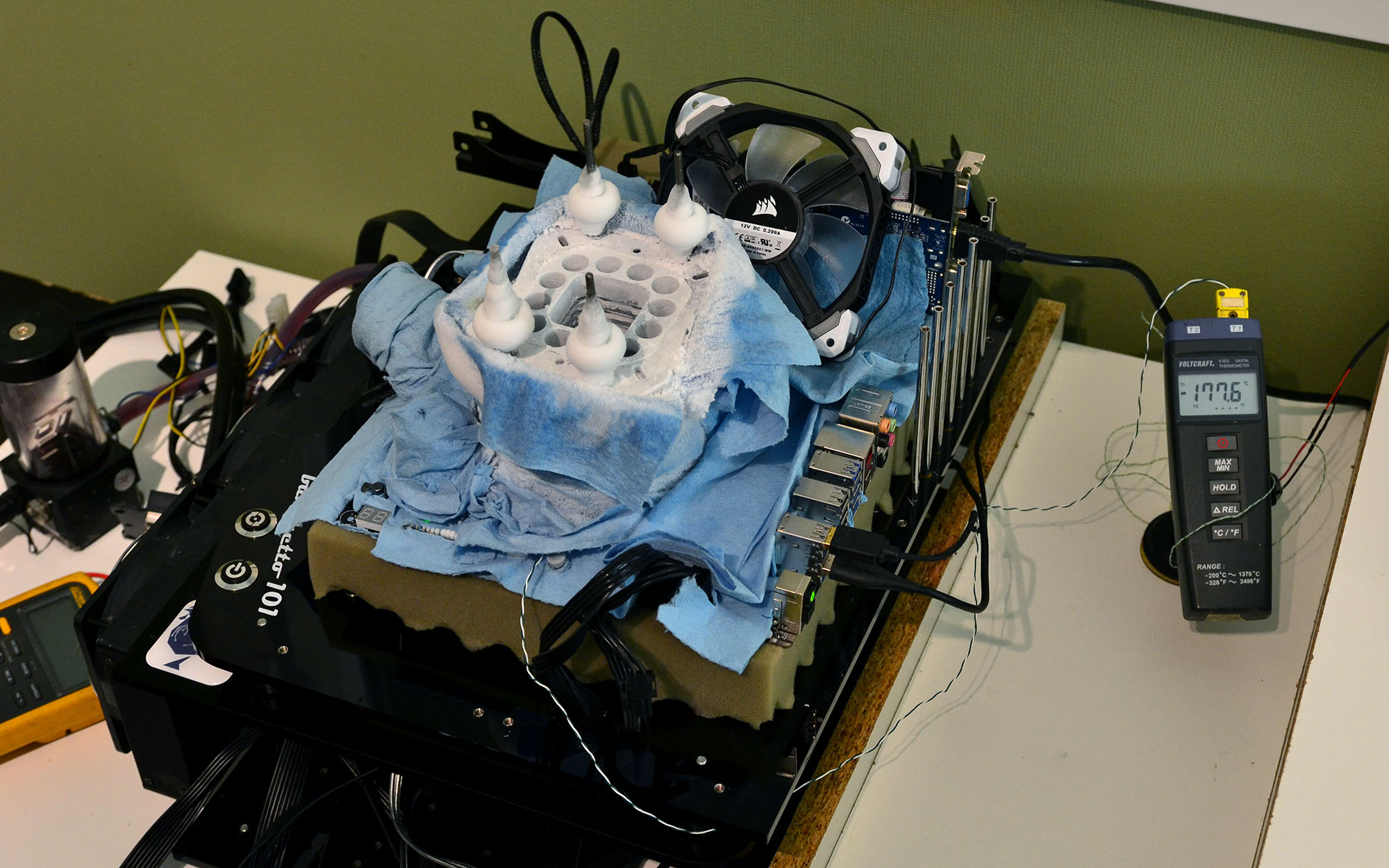Extreme Overclocking: 10 Ryzen CPUs Under LN2
1800X: First Test Of Scaling With LN2
By luck, we chose the best Ryzen 7 1800X for our scaling trials right out of the gate.
Ryzen 7 1800X : Frequency As A Function Of Temperature At 1.5V
This first experiment explores how the processor behaves at different temperatures with its core voltage fixed at 1.5V. That seems really high for a test at ambient, and we don't want to damage our CPU just for the sake of generating a chart. On the other hand, once the 1800X is at -196°C, a voltage of 1.5V is actually pretty conservative. In the end, we picked this value as the best compromise between risk at ambient and extreme overclocking performance.
At room temperature (20°C), the processor passes a Cinebench R15 run at 4175 MHz. This is a high frequency for Ryzen, achieved at significant risk. Don't try this at home: warm silicon doesn't like aggressive voltage settings.
By lowering the temperature to 0°C, we're able to dial in a 100 MHz frequency increase. So far, we have an improvement of around 5 MHz/°C.
We continue to lower the temperature by pouring liquid nitrogen in the cooling pot until we arrive at -50°C. The frequency gain is now 250 MHz. Our progression remains constant with the same rate of 5 MHz/°C.
Next we see -100°C, giving us an additional 200 MHz. The trend begins to flatten, indicating that the scaling progression is slowing down slightly (4 MHz/°C).
An additional 50°C drop in temperature shows a gain of only 175 MHz at -150°C. The increase is 3.5 MHz/°C.
Get Tom's Hardware's best news and in-depth reviews, straight to your inbox.
For the last step, we reach full pot. At -196°C, with a 46°C drop in temperature, the clock rate stabilizes at 5025 MHz (2.7 MHz/°C).
A full pot signifies that our chamber is filled to the brim. We are at the minimum temperature permissible with liquid nitrogen, which is -196°C. To go any lower, you'd need liquid helium: -269 °C.
Thanks uniquely to the reduced temperature, our sample passes Cinebench R15 with an additional 850 MHz overclock. When you hear that these processors love the cold and are damaged by heat, here is the proof.
Ryzen 7 1800X : Frequency As A Function Of Core Voltage At -196 °C
The next experiment tracks our CPU's behavior at various core voltages with a temperature held constant at -196°C. Only the voltage changes; all other parameters remain unchanged.
At 1.5V, we hit the same clock rate seen in the previous set of tests. This makes sense, of course. However, we'll take the time to mention how well our sample scales. In fact, some of the CPUs we tested couldn't hit 4175 MHz even at a core voltage of more than 1.8V.
With an additional 0.1V, the frequency increases 100 MHz. This is significant, but not exceptional. As a reminder, we saw the same gain under air cooling when transitioning from 1.3 to 1.4V, while the shift from 1.0 to 1.1V offered a superior increase of 250 MHz. Before starting these tests, we would have guessed that the clock rate gained by increasing voltage would be amplified at lower temperatures. That's not the case, though.
The same observation applies when we raise the core voltage an additional 0.1V to 1.7V (+100 MHz).
For the next step, we stabilize 75 MHz higher at 1.8V. This frequency is remarkable: 5300 MHz. Such a clock rate is not common with Ryzen.
We halt the trial at 1.85V. Going any higher yields no frequency increase, and the voltage settings start becoming hazardous to our guinea pig.
The progression we just saw cannot be extrapolated to all Ryzen CPUs at the temperatures and voltages we used for testing. Certain specimens will fare worse when cold, some won't accept more than 1.75V, and others will continue scaling beyond 1.9V. This sample is above average though, even if it's always possible to find something better.
MORE: Best CPUs
MORE: How To Overclock AMD Ryzen CPUs
MORE: De-Lidding and Overclocking Core i7-7700K
MORE: CPU Overclocking Guide: How (and Why) to Tweak Your Processor
Current page: 1800X: First Test Of Scaling With LN2
Prev Page Preparing The RAM Next Page Lapping The CPU-
InvalidError It isn't surprising that the highest-end CPUs have the highest and least troublesome overclocks as that's what chip binning is for - the best dies go to the premium SKUs first, lower tiers get what is left over.Reply -
-Fran- Reply19937674 said:It isn't surprising that the highest-end CPUs have the highest and least troublesome overclocks as that's what chip binning is for - the best dies go to the premium SKUs first, lower tiers get what is left over.
Even more, it's very interesting since it gives some credibility that AMD is not binning due to defects, but electrical properties, hence, making the rumour mill of being able to unlock some 4C and 6C to higher core counts not that far-fetched.
Cheers! -
Wisecracker Très bon!Reply
(hope I used this correctly)
Just wondering ... would it be considered a 'faux pas' (or, an insult to AMD) to release the batch numbers?
-
theyeti87 Reply19937697 said:19937674 said:It isn't surprising that the highest-end CPUs have the highest and least troublesome overclocks as that's what chip binning is for - the best dies go to the premium SKUs first, lower tiers get what is left over.
Even more, it's very interesting since it gives some credibility that AMD is not binning due to defects, but electrical properties, hence, making the rumour mill of being able to unlock some 4C and 6C to higher core counts not that far-fetched.
Cheers!
Wasn't that a similar case with the Phenom X4, X3, and X2's? Or were those 3's and 2's disabled cores due to defect? -
-Fran- Reply19937706 said:19937697 said:19937674 said:It isn't surprising that the highest-end CPUs have the highest and least troublesome overclocks as that's what chip binning is for - the best dies go to the premium SKUs first, lower tiers get what is left over.
Even more, it's very interesting since it gives some credibility that AMD is not binning due to defects, but electrical properties, hence, making the rumour mill of being able to unlock some 4C and 6C to higher core counts not that far-fetched.
Cheers!
Wasn't that a similar case with the Phenom X4, X3, and X2's? Or were those 3's and 2's disabled cores due to defect?
They were a mix of both. If you were lucky (and could track down some of the batches) you were able to unlock the CPU with little worry, but there were defective ones that when unlocked, would not work. I came across both myself.
To be honest, I just catalog it as "interesting", because I will pay the difference to always get the full working version, but I do know there's people out there that like gambling and can track batch numbers :P
Cheers! -
InvalidError Reply
The relatively low defect rate has been a given since launch IMO: half of each CPU core is L2 cache and half of the CCX die area is the L3, so you have a 50% chance that defects within a CCX will land in L3. If the defect rate had been significant, cache defects would have forced AMD to launch models with 8MB of L3 long before the 1400.19937697 said:Even more, it's very interesting since it gives some credibility that AMD is not binning due to defects, but electrical properties -
-Fran- Reply19937880 said:
The relatively low defect rate has been a given since launch IMO: half of each CPU core is L2 cache and half of the CCX die area is the L3, so you have a 50% chance that defects within a CCX will land in L3. If the defect rate had been significant, cache defects would have forced AMD to launch models with 8MB of L3 long before the 1400.19937697 said:Even more, it's very interesting since it gives some credibility that AMD is not binning due to defects, but electrical properties
True. It's just nice to have more non-validated statistical-irrelevant proof! Haha.
Cheers! :P -
Gregory_3 This is all kind of cute, but the real market success will be played out in conventional liquid cooled and air cooled environments. Nobody is going be running high end software with condensation dripping all over.Reply -
InvalidError Reply
There wouldn't be condensation issues if OCers used the nitrogen gas boiling out of the pot to displace air and the moisture it contains around the motherboard to keep it off of it. Instead of circulating the boil-off around the motherboard though, LN2 OCers use fans to suck it away, drawing more moisture-ladden air in the area.19938043 said:Nobody is going be running high end software with condensation dripping all over.
-
gasaraki "It isn't surprising that the highest-end CPUs have the highest and least troublesome overclocks as that's what chip binning is for - the best dies go to the premium SKUs first, lower tiers get what is left over."Reply
While it might not be surprising, it shows the immaturity of the Ryzen processors in that the build quality is not the same between different CPUs or even CCXes and binning is what they do for the lower cored versions. If your build process was mature ALL your chips would come out mostly the same and "awesome" then at that point your forced to just shutdown cores to make the lower cored processors.


